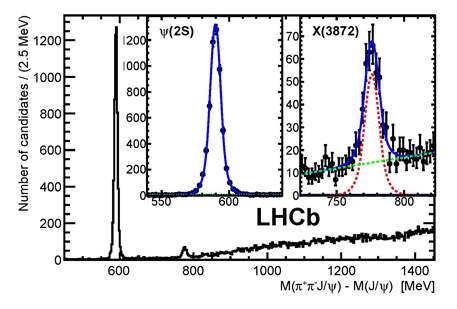[ X(3872) JPC = 1++ ]
The LHCb Collaboration presented today at the Rencontres de Physique de la Vallée d’Aoste, La Thuile, Italy, an important result which makes the exotic nature of the X(3872) particle very probable.
In the quark model of particle physics proposed in 1964 by Murray Gell-Mann and George Zweig mesons, like the π (pion), are formed from quark and anti-quark pairs and baryons (like the proton) from three quarks. This model is very successful. Particles which cannot be described in this model, known as exotic states, have been searched for since nearly 50 years ago. Their existence has not yet been firmly established (except of a special case of pionium). One of the most famous candidates for such an exotic state is called the X(3872). It was discovered in B+ meson decay into an X(3872) and a K+ meson by the BELLE collaboration almost 10 years ago. Its existence was confirmed later by the CDF, D0 and BaBar experiments. LHCb has previously reported studies of the X(3872) in the data sample taken in 2010, see 27 October 2010 news. Particles are classified according to their quantum numbers JPC. An analysis by the CDF experiment has limited the possible values of X(3872) JPC to either 1++ or 2-+.
LHCb physicists have observed the X(3872) particle in the decay of a B+ meson into an X(3872) and a K+ meson. The X(3872) was observed in the invariant mass of a J/ψ particle and a π+π– pair, while the J/ψ was identified from its decay into μ+μ– pair. The image at the left hand side shows the difference between the invariant mass of the π+π–J/ψ combination and the J/ψ showing clearly the X(3872) and ψ(2S) enhancements over the smooth background distribution (the ψ(2S) particle decays also into a π+, π–, and J/ψ).
.
click the image for higher resolution
LHCb physicists made a sophisticated analysis of the whole B+ decay chain in 5 dimensions and unambiguously determined the quantum numbers of X(3872) to be 1++. The other previously allowed assignment of 2-+ was rejected with statistical significance over 8σ. About 300 signal events were selected among about 60 million million (6*1013) pp collisions seen by the LHCb detector at LHC during the 2011 data taking period. Details of analysis can be found on the LHCb staff page.
The exotic nature of the X(3872) would be unambiguously determined if its quantum numbers could not be described by the quark-antiquark combination. However, this is not the case. In fact, the mass of 3872 MeV is located in a region in which many charm quark-antiquark states are present bound by a strong force in an atom-like system called charmonium. The X(3872) has the quantum numbers of an as yet unobserved charmonium state called χc1(23P1). However, the charmonium spectrum is very well understood and the mass of the X(3872) makes this assignment very unlikely. Possible exotic explanations of the X(3872) nature include a DD* or multi quark anti-quark system such as a diquark-diantiquark tetraquark or charmonium-molecule mixture.
More details can be found in the LHCb presentation in La Thuile and in the LHCb paper here. Read also the CERN Courier article and the CERN Bulletin article in English and French.

